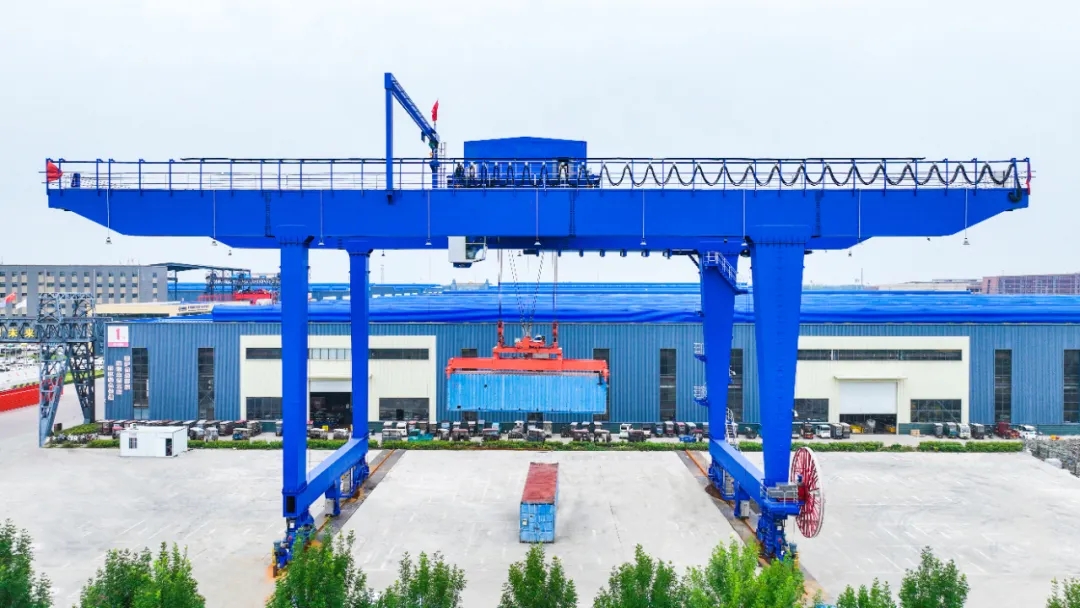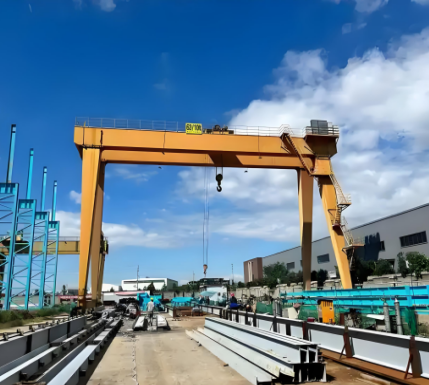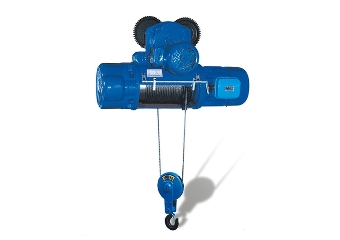Intermodal Gantry Cranes (RMG & RTG) — Engineering Playbook
This engineering-oriented guide targets rail-to-truck operations, inland ports (ICDs), and rail container hubs. It provides practical selection and implementation advice for RMG/RTG cranes—covering layout (6+1/8+1), common specifications, power-supply boundaries, automation tiers, wind/safety design, energy & TCO methodology, deliverables, and risk controls—so projects can make sound decisions at concept, bid, and procurement stages.
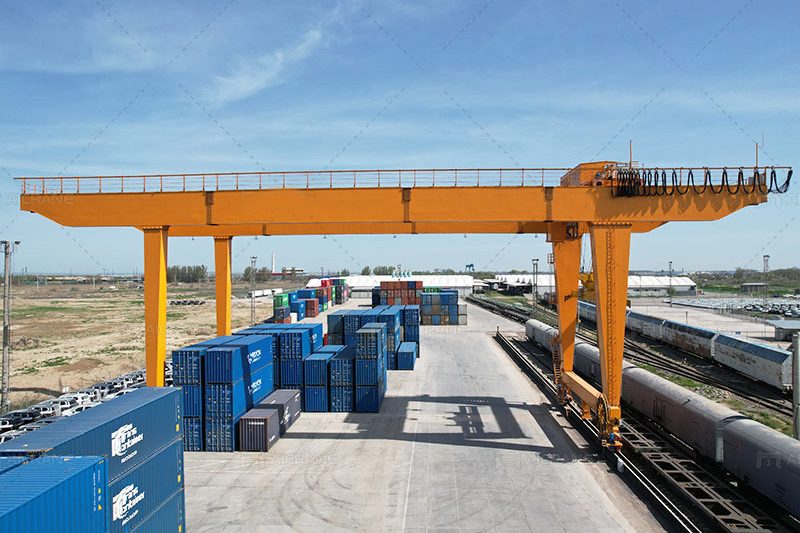
RMG Intermodal Crane
Fixed rail tracks, the intermodal RMG crane is ideal for railway freight terminals, intermodal container yards, ports with rail connections.
Specifications:
- Lifting capacity: 30t, 35t, 40.5t, 45t, 50t (customizable)
- Span: 18-35m (customizable)
- Lifting height: 12.3-21m (customizable)
- Work duty: A6-A8

RTG Intermodal Crane
Mounted on rubber tires, the intermodal RTG crane is suitable for port container terminals, multi-modal logistics hubs, large intermodal yards requiring flexible container handling.
Specifications:
- Lifting capacity: 30t, 35t, 40.5t, 45t, 50t (customizable)
- Span: 18-35m (customizable)
- Lifting height: 12.3-21m (customizable)
- Work duty: A6-A8
1. Why Intermodal Gantry Cranes
- High density: 6+1 / 8+1 block stacking; typical stacking height 1-over-5/6; excellent land use.
- Deterministic paths: RMGs run on rails—precise motion enables remote or semi/fully automated upgrades.
- Lower local emissions & noise: electrified drives / cable-electric options reduce kWh/TEU and sound levels.
- Consistent cycle times: anti-sway, path anti-collision, stack profiling, and anemometer interlocks support stable day-and-night operations.
Further reading (internal link): RMG Crane vs RTG Crane: Which One Fits Your Yard?
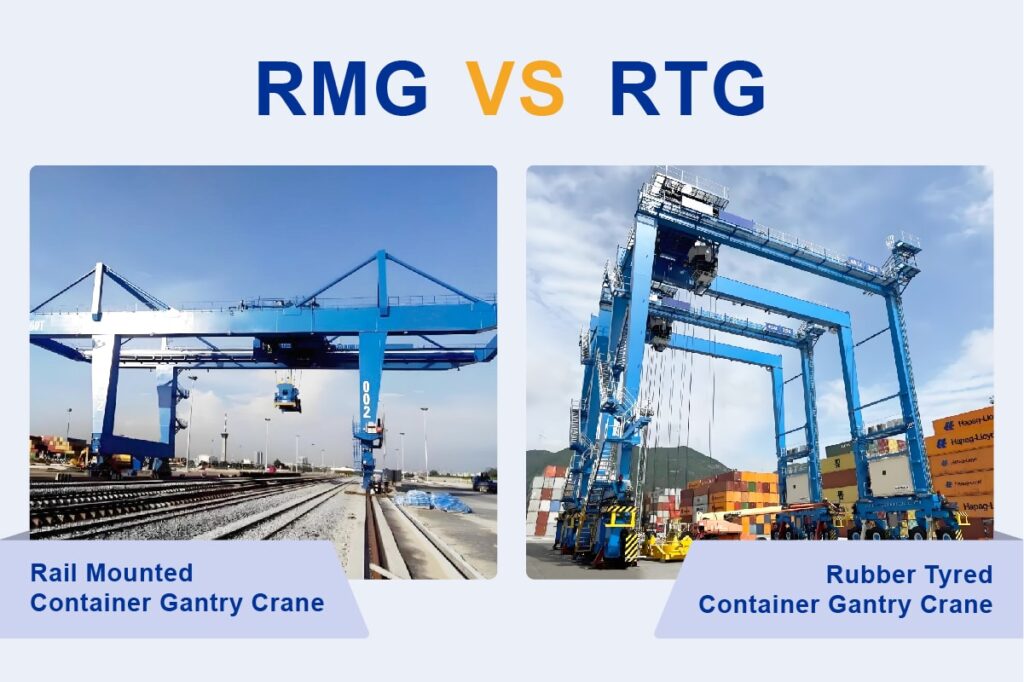
2. How It Works: Key Components & Operating Cycle
2.1 Key Components
- Gantry structure: main girder with rigid/hinged legs; covers in-span stacks with optional cantilever truck lanes.
- Hoisting system: motor–gearbox–drum–rope–spreader/telescopic spreader; over-hoist protection and soft-landing functions.
- Trolley system: traversing unit carrying the hoist; equipped with positioning sensors and sway suppression.
- Gantry travel: RMG on rails; RTG on tyre chassis; includes slow-down zones, end stops, and anti-collision.
- Spreader: 20’/40’/45’ telescopic, optional rotator, anti-twist, and box ID aids.
- Power & control: RMG (busbar/cable reel), RTG (diesel/hybrid/cable-electric); PLC + vector VFD; remote operation and TOS integration ready.
2.2 Standard Operating Cycle
1) Truck/train positioning → 2) Target slot confirmation (with TOS/YS) → 3) Spreader alignment & lock-on →
4) Hoist with sway suppression → 5) Travel (path anti-collision) → 6) Decelerate & soft landing → 7) Unlock & depart.

3. Common Specification Ranges (aligned with industry expressions)
- Rated load under spreader: 30 / 35 / 40.5 / 45 / 50 t (verify with box mix and load cases).
- Span (rail gauge + overhangs): 18–35 m (typical RMG); large-span 32–50 m for 8+1 layouts.
- Hoisting height: 12.3–21 m (typical range; depends on stacking height and rail elevation).
- Stacking height: 1-over-5 / 1-over-6 (allow margin for extreme box configurations).
- Speed ranges: hoist 12–30 m/min; trolley 60–120 m/min; gantry 60–120 m/min.
- Duty class: A6–A8 (based on peak-hour moves, daily utilization, and load spectrum).
- Spreader: 20’/40’/45’ telescopic; options for rotator and torque monitoring.
- Environmental packages: coastal/low-temperature/dust & sand (coatings, sealed enclosures, heaters/dehumidifiers).
4. RMG vs RTG — Engineering Comparison (operations-first view)
Dimension | RMG (Rail-Mounted) | RTG (Rubber-Tyred) |
Mobility & planning | Fixed rails; deterministic paths; ideal for fixed blocks & long-term plans | Free roaming; suited to phased expansion and variable block layouts |
Layout / span | 6+1 / 8+1; single/double cantilever options | 5–7 rows (tyre-base dependent); can shuttle across areas |
Stacking height | 1-over-5/6 (typical); easier to sustain stable heights | 1-over-4/5 (typical) |
Drives & energy | Fully electric with regen; generally lower kWh/TEU | Diesel/hybrid/cable-electric; typically higher energy & noise |
Automation path | Trackable motion; friendly to remote/semi/fully automated ops | Semi-automation/remote common; full automation is more complex |
CAPEX vs OPEX | Higher CAPEX; lower OPEX | Medium CAPEX; medium OPEX (tyres/chassis included) |
Maintenance focus | Rails, busbar/cable reel, power & controls | Tyres/chassis/engine (diesel), steering, power & controls |
Typical yards | Rail terminals, inland depots, fixed blocks | Mobile blocks, mixed-use yards |
5. Power-Supply Boundaries: Busbar vs Cable Reel (RMG)
Selection notes:
- Travel length & cycle: long runs/frequent shuttles with curves favor cable reels; straight, repetitive runs often favor busbars.
- Maintenance strategy: busbars focus on collector shoes & cleanliness; cable reels on cable fatigue life & slip-ring service.
- Redundancy & downtime: busbars can be segmented/bypassed; cable reels can route around local obstacles.
- Civil & installation: busbars require continuous installation space; reels need robust mounting and tail-room at ends.
6. Automation Tiers & Sensor Stack
Upgrade ladder:
- Tier 1: anti-sway, slow-down zones, soft landing, obstacle detection, path anti-collision.
- Tier 2: laser/vision/DGPS positioning, stack profiling, truck-lane guidance, OCR for box IDs.
- Tier 3: remote operation station (multi-crane), workload orchestration, alarm linkage.
- Tier 4: deep TOS/YMS integration for semi/fully automated cycles; rules for exception handling.
7. Wind & Safety: Critical Devices & Interlocks
- Wind monitoring & interlocks: anemometer → PLC → staged alarms/limits/stop/anchoring.
- Storm anchors & rail clamps: normal clamping + storm anchoring; designate storm parking positions with anchors.
- Overrun/anti-collision: end stops + buffers + laser/radar zones; safe logic at rail crossings.
- Emergency & rescue: brake release, hand pump, emergency lowering/unlock procedures.
8. Layout Details: 6+1 vs 8+1 & Truck Lanes
- 6+1: balanced CAPEX and accessibility; suited to mid throughput, shorter spans, and normal wind zones.
- 8+1: maximum land use; check higher spans, beam depth, wheel loads, and wind-proof configuration.
- Truck/UTR lanes: straight approaches, adequate marshalling length and turning radius; clear guidance and camera coverage.
- Interfaces: clearance at crossings, guard rails and light curtains; rail sweeping and drainage management.
9. Energy & TCO: Methodology & Guidance
Methodology: estimate energy using kWh/TEU multiplied by annual utilization based on load spectra and motion counts; include regenerative braking recovery in net energy. Compare RMG (electric) with RTG (diesel/hybrid/cable) by converting to equivalent cost.
Guidance: under stable duty cycles, RMGs typically deliver lower kWh/TEU and more predictable maintenance windows; RTGs trade higher mobility for energy and chassis-related maintenance.
10. Procurement Inputs & Deliverables
- (From owner) yard drawings (DWG/PDF), peak-hour moves & shifts, target stacking/span, power concept, wind/temperature/corrosion data.
- (From supplier) layout drawings, key parameters, loads & wheel loads, single-line power diagrams, control concept, wind/extreme-condition notes, installation/commissioning/training plan.
11. Risks & Mitigations
- Insufficient checks on rail gauge & foundation capacity → perform structural verification and settlement monitoring plan.
- No storm parking/anchoring in high-wind zones → add wind-proof design and interlock strategy.
- Conflicts in cable/busbar routing → coordinate civil interfaces early.
- Late changes in sensor stack or TOS interfaces → freeze interface list and acceptance test cases up front.

Expert in Overhead Crane/Gantry Crane/Jib Crane/Crane Parts Solutions
Eileen Hu
With 20+ years of experience in the Crane Overseas Export Industry, helped 10,000+ customers with their pre-sales questions and concerns, if you have any related needs, please feel free to contact me!
Frequently Asked Questions (FAQ)
Check land-use rigidity + peak throughput + automation goals: fixed blocks and automation favor RMG; mobility and phased expansion start with RTG.
Straight repetitive runs lean to busbars; long/curved routes lean to reels; factor in maintenance and redundancy.
Yes: anti-sway → positioning → remote station → semi/fully automated cycles; pre-allocate sensor conduits and cabinet space.
6+1 balances investment and accessibility; 8+1 maximizes density but demands higher spans and wind-proofing.
Use corrosion-resistant coating systems, sealed electrical enclosures, heaters/dehumidifiers; low-temperature materials/lubricants; enhanced sealing and filtration for dust.
Intermodal Gantry Cranes (RMG & RTG) — Engineering Playbook
Intermodal Gantry Cranes (RMG & RTG) — Engineering Playbook This engineering-oriented guide targets rail-to-truck operations, inland ports (ICDs),
Electric Hoist Gantry Crane: Complete Sizing & Selection Guide | SLKJCrane
Electric Hoist Gantry Crane: A Complete Sizing & Selection Guide Choosing the right electric hoist gantry crane comes
MG Double Girder Gantry Crane with Hook | Heavy-Duty Outdoor Lifting
MG Double Girder Gantry Crane with Hook: Structure, Specs & Applications An MG double girder gantry crane with
Steel Mill Wire Rope Lubrication for Metallurgical Hoists | Cut Downtime by 41%
Steel Mill Wire Rope Lubrication for Metallurgical Hoists: Root-Cause Fix & Proven Results Wire rope failures in steel
Contact Us Now
Have questions about our cranes or need help?
Reach out to our friendly team for expert support and guidance.
We are here to help you power your journey towards a greener future !
Address: Crane Industry Park, Xinxiang City Henan Provice

